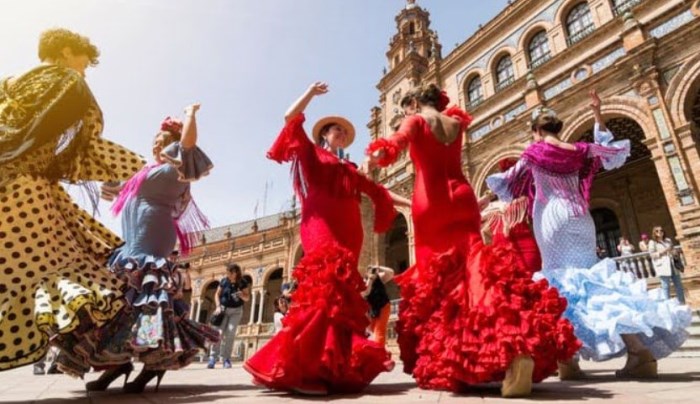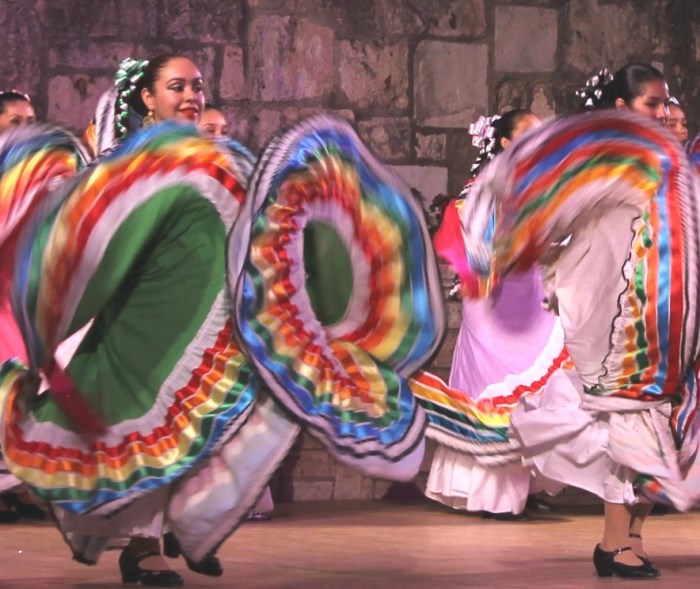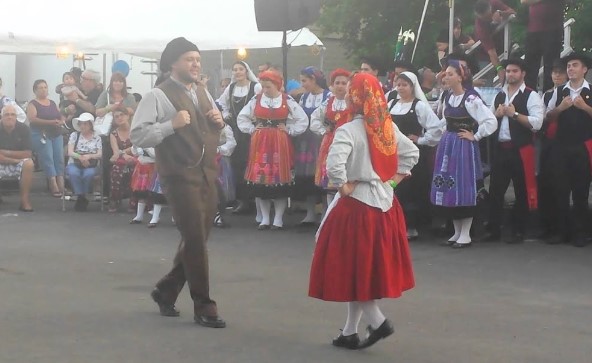The Fandango dance is more than just a foreign word in the lyrics of Queen’s “Bohemian Rhapsody.” Since the 1700s, it’s been one of the more popular Latin dances in the repertoire.
Even today, centuries after the peak of its popularity came and went, the Fandango still has small communities around the world dedicated to practicing and teaching it.
Energetic and lively, what’s not to love?
But knowing about the Fandango is one thing, if you’re truly invested in this dance, you’ll probably want to know its origin and history, too.
That’s what today’s article will be about: exploring the origins of the Fandango dance, tracing its roots back to its early beginnings, and examining how it has evolved over time!
Table of Contents
What Is Fandango Dance
But first, for the uninitiated, let’s talk about what the Fandango dance is, first.
It is a Spanish partner dance (meaning performing is a team of two dancers or a couple). The dancers will move in a series of rhythmic Fandango dance steps and turns, accompanied by the sound of the castanets and the strumming of guitars.
First, it’ll start out slow, with the rhythm set by clacking castanets, clapping hands, snapping of fingers, and stamping of feet. As the dance progresses, the musicians will gradually speed up the tempo, with the music being played in either 3/4 or 6/8 time.
And of course, the dancers are expected to keep up as best as they can. The speeding is an opportunity to showcase one’s dancing skills!
But in the Fandango, it’s not just about moving as fast as possible. There are plenty of challenges that either the musician or the opposing partner will put out for you.
For example, sometimes, the music will come to a sudden halt, and the dancers will have to freeze in place until the music resumes. Partners may playfully tease and challenge each other by leading the other through a series of intricate steps and gestures.
Over the years, there have been many different variations and modifications to the Fandango.
As an example, in one variation, the Fandango becomes a contest of skill between two male dancers. The first dancer sets the rhythm and steps, while the second dancer elaborates and adds his own unique variations.
Since it’s a ballroom dance and was picked up by aristocrats at its height of popularity in the 18th century, the Fandango is a fairly structured dance with full choreographies and sets of moves to follow.
In another, it’s a courting dance, performed between a man and a woman with the ultimate objective of bringing themselves closer to each other.
Today, Fandango dancers wear traditional Spanish Fandango dance costumes any time they perform. Which means colorful dresses for women and tight-fitting pants with a short jacket for men.
As for the word Fandango’s meaning, the word is synonymous with “a quarrel” or “a brilliant exploit” in Spanish.
Fandango Dance Origin & History
The Fandango first came to being in Spain during the 18th century.
The earliest record of the word “Fandango” was in an anonymous book named “Libro de diferentes cifras de guitarra” written around 1705. The Fandango in the book was mentioned as a melody (the song form came earlier than the dance.)
A few years later in 1712, the first record of the Fandango dance itself came in a letter by Martín Martí, a Spanish priest. In it, he described the Fandango dance in detail among the folks.
So where did the fandango dance originate, really? In Spain.
But by whom?
Well, like most folk dances, nobody really knows exactly who invented it or where it came from.
By the mid-1720s, we already have the first theatrical adaptation of the dance in Francisco de Leefadeal’s entremés “El novio de la aldeana”, which was staged in Seville around the 1720s.
It wasn’t until the 18th century that the aristocrats began to take note of the Fandango dance and started to use it as a sort of social ballroom dance.
Over the years, the Fandango dance has gained several new variations. Each variation is named depending on the region that it came from.
For example, the Fandango de Huelva, which is so-called because it was first performed in the Huelva province in southern Spain. Another is the Fandango de Málaga, which is associated with the Málaga province in Andalusia.
The Fandango wasn’t just popular in Spain. Because playwrights, opera composers, and choreographers love the Fandango so much, it’s appeared in many tonadillas, zarzuelas, ballets, and operas.
And through those pieces, the Fandango was spread through Europe and beyond, making it known to people in many countries – not just Spain alone!
Check more: Circle Dance: Origin, Types, Steps, Music
Fandango Dance In Spain
In Spain, much of the characteristics of the original Fandango were preserved.
The dance is done to ¾ pattern and has a distinctive progression (I-IV-V) for the lyrics with octosyllabic verses (written in eight syllables). And the band typically includes castanets and guitars.
There are two popular styles of the Fandango in Spain.
- The first (and most popular) is the fandangos grandes (big fandangos). It first starts out slowly, then picks up speed as the dance progresses. When people talk about fandango, this is what they’ll most likely be talking about.
- Next is the mirror opposite of the fandangos grandes, which is the fandanguillos (small fandangos.) It’s livelier and more festive than the grandes version.
Besides these two big styles, the Fandango dance in Spain has numerous smaller regional variations, like the Fandango de Huelva and the Fandango de Málaga that we mentioned earlier!
Costumes
In Spain, the costume for Fandango dancing is similar to the costume for Flamenco. Female dancers will perform with a blouse and a long, flowy skirt. Their hair is usually tied back with castanets on their fingers.
Male dancers will wear tight-fitting pants made from stretchable and breathable materials so that they can dance more comfortably. On top, they’ll usually wear a short jacket made from silk or other fine materials.
They may also choose to wear accessories like a sash or a scarf around their waist.
Fandango Dance In Veracruz, Mexico
In Veracruz, Mexico, Fandango is done by dancers on top of a wooden platform (Tarima.) The variation of the Fandango in Veracruz has some steps that are very similar to the Flamenco.
Why the popularity in Veracruz?
Well, it’s a port city where most of the cultural exchange between Mexico and Spain took place. Back then, it’ll be the first place that the original form of the Fandango landed.
Check more: Facts About Mexican Dance Dresses
Costumes
The dance costume for Fandango dancers in Veracruz isn’t all that different from those in Spain.
Female dancers still wear a blouse and a flowy skirt that accentuates their every movement. Male dancers will perform with tight pants and a loose, decorated blouse.
Fandango Dance In Portugal
In Portugal, the Fandango is one of the main folk dances. Unlike the dance that’s done between a man and a woman in Spain or Mexico, the variation in Portugal is done by two male dancers.
The dancers will face each other and take turns to showcase their skills. The purpose of Fandango dance in this case is to demonstrate the lightness of their body and the deftness of footwork.
In some variations, the dancers can be of different genders or the same gender.
The “fandango do Ribatejo” is a specific form of fandango that originates from the Ribatejo region of Portugal. This version of the dance is usually performed by two Campinos, or cowboys, who showcase their mastery of footwork and coordination while teasing each other in a playful manner.
Fandango Dance Music
The earliest record of the Fandango isn’t about the dance … but about the music. Music is an essential component of the Fandango dance. It provides the rhythm and beat that, in turn, drives the dancers’ movements.
The music for Fandango is typically played on traditional Spanish instruments, such as the guitar, castanets, tambourine, and handclaps. The star of the show in a Fandango band is the classical guitar, which sets the tone for the performance with its melodic quality.
The Fandango dance music is usually in 3/4 or 6/8 time, with a fast tempo that gradually increases throughout the dance. The music may feature sudden pauses, with the dancers freezing in place until the music resumes.
These pauses, other than being an interesting musical challenge that dancers have to anticipate, are a signature feature of the Fandango. It’s sort of an interlude to let the dancers take a breath after the vigorous show and steel themselves for the next round of dancing.
In addition to the guitar, other instruments may also be used to accompany the Fandango dance. These may include the flute, accordion, and violin.
Final Words
For centuries, the Fandango dance has been the beating heart of Spanish, Portuguese, and Mexican culture. With its simple choreography and lively music, the Fandango continues to be a cherished part of these countries’ cultural heritage.
We hope this short guide has answered all of the questions and wonders you have about the Fandango dance! If you have anything else you’d like to know, don’t hesitate to leave a comment down below.



